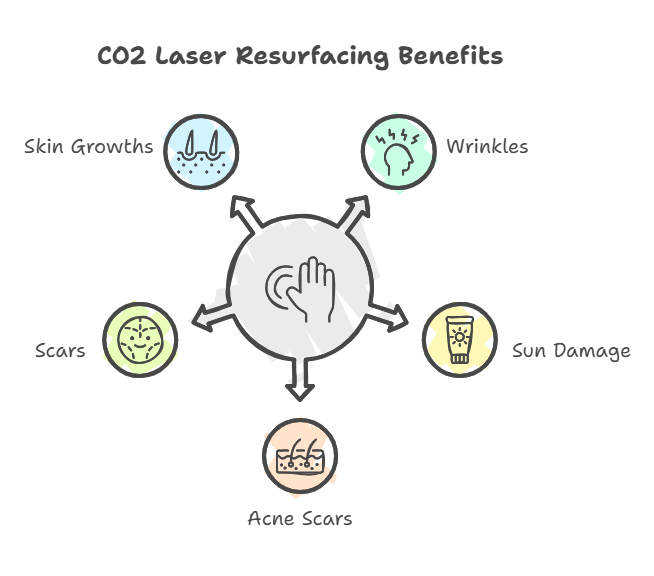Have you ever wondered how some folks manage to maintain youthful-looking skin? Some people get standard facials, but others might try more sophisticated methods. One treatment that gets a lot of attention is c02 laser resurfacing. But what does c02 laser do, and is it right for you?
“CO2 laser resurfacing remains one of the most effective treatments for skin rejuvenation, offering significant improvement in skin texture and tone. However, it’s essential for patients to have a thorough consultation with a qualified professional to understand the procedure and set realistic expectations.”
Dr. Arash Akhavan
Many people considering skin rejuvenation options are often curious about the c02 laser. It addresses everything from wrinkles and sun damage to acne scars and skin cancer.
What is CO2 Laser Resurfacing?
This laser treatment uses carbon dioxide to precisely remove thin layers of damaged skin. Think of it as a controlled injury that encourages your skin to heal itself in a more youthful way. It promotes smoother, healthier skin as it heals.
How CO2 Lasers Work
So, how does a CO2 laser actually work its magic? The CO2 laser emits energy at a wavelength of 10,600 nanometers. That energy is absorbed by the water in your skin cells, which causes the cells to vaporize.
When the laser heats the skin, it triggers the production of collagen. Collagen is a protein that provides a tightly organized fiber network contributing to the skin’s elasticity. This protein helps give skin its structure and firmness. A carbon dioxide laser uses a laser beam to target and treat skin1.
Here’s an example table to compare traditional ablative vs. fractional lasers:
| Type of CO2 Laser | How It Works | Benefits | Downsides |
|---|---|---|---|
| Ablative CO2 Laser | Vaporizes the top layer of skin | More dramatic results, effective for severe damage | Longer recovery time, higher risk of side effects |
| Fractional CO2 Laser | Applies many microbeams, leaving surrounding tissue intact | Faster recovery, lower risk of side effects | Less dramatic results, may require multiple treatments |
As you can see from the above chart, different lasers have varying qualities and may be best suited for particular people. With that in mind, let’s get more granular so that you fully understand the specific kind of CO2 laser treatment.
Ablative versus Fractional CO2 Lasers
Ablative CO2 lasers remove the entire superficial layer of skin. They can provide more dramatic results, but the recovery time is longer and carries a higher risk of side effects.
Fractional c02 laser treatment, on the other hand, treats only a fraction of the skin. Fractional lasers use a large number of microbeams to create columns of ablation. Fractional c02 lasers reduce the risk of negative effects since only certain portions are targeted2.
So which one is right for you? It depends on your skin’s condition and what you want to achieve. It is best to have this discussion with your doctor to figure out what is optimal.
Benefits of CO2 Laser Resurfacing
So what are the specific benefits of a c02 laser? What are its key features for someone considering it? Let’s cover these features so that it is clear and upfront for people reading. The laser resurfacing process stimulates collagen production.
- Reduces fine lines and wrinkles.
- Repairs sun-damaged skin.
- Improves acne scars.
- Addresses uneven skin tone and texture.
- Treats certain benign skin growths.
A 2018 review showed that ablative fractional CO2 lasers can reduce acne scars. Also, according to a 2024 study, c02 lasers safely and effectively improve the appearance of papular acne scars3. Now, who would have thought you can treat that with CO2 lasers?
Conditions Treated with CO2 Laser Resurfacing
This is one reason people look to lasers, because they are tired of products and they simply need more support. Some people choose the laser option for warts, but this may not always be a first choice of action as doctors may first try more minor actions that are less extreme first.

Lasers may come in when other things don’t work. The laser is just there for added support for those difficult situations. A c02 laser can address these skin conditions:
- Wrinkles: Can reduce the appearance of fine to moderate wrinkles.
- Sun Damage: Reverses the effects of prolonged sun exposure.
- Acne Scars: Smoothes and improves the appearance of acne-related scarring.
- Scars: Reduces the appearance of certain mild scars on the skin.
- Skin Growths: Can remove growths such as actinic keratosis and seborrheic keratosis.
Now, this may be exciting information, but there are considerations before one commences any kind of CO2 laser process. It’s so important to find out first if the procedure is best for you, even if a professional says its ideal.
Your doctor or dermatologist needs to examine your needs and come to the right choice, because its your health and livelihood first and foremost. If you are not the ideal candidate, there are alternative options.
Am I a Good Candidate for CO2 Laser Resurfacing?
Lasers might seem like a magic wand, but not everyone gets the same results. Your skin type actually matters. This is crucial because c02 lasers generally work best for individuals with Fitzpatrick skin types 1 or 2. People with skin types may consider other options.
Now, you might wonder if a CO2 laser is safe for all skin tones. While it’s particularly effective for lighter skin, a 2017 review suggests that non-ablative fractional lasers may be a better option for individuals with Fitzpatrick skin types 4 to 6. However, a 2023 study confirmed that CO2 laser treatments are safe and effective across all skin types. If you’re exploring alternative treatments, RF microneedling may also be a suitable option, especially for those with darker skin tones. Learn more about its benefits here.
However, this assumes the treatment is performed by a trained dermatologist. People with darker skin tones sometimes experience adverse effects, so you really should consult with professionals before proceeding. Proper aftercare instructions are important after the procedure.
What to Expect During the Procedure
When going in for your c02 laser treatment you should expect numbing, cleaning, and eyewear. Your dermatologist will numb the treated area and then clean your skin thoroughly. Also, you’ll receive special eyewear to shield your eyes from the laser. The outpatient procedure usually takes about 30 minutes to 2 hours.
Remember to follow your dermatologist’s aftercare instructions to reduce healing time. Stay at home and also don’t pick at your skin to heal successfully and minimize complications. Your health is the most important thing.
What is the recovery time?
As much as people would love instant fixes, treatments may require 6 months before the full inflammation subsides. However, skin needs around 6 weeks to heal after a c02 laser treatment4.
During the first few days post treatment the skin may be quite raw, feel sunburned, and drain. Your healthcare provider may also put a bandage over the treated area.
Consider these aftercare steps to have the safest healing environment:
- Minimize direct sun exposure.
- Use sun protection, like sunscreen.
- Attend follow-up appointments to monitor recovery.
- Take prescribed medications.
Now that you have undergone your procedure, lets briefly check the overall cost factor as there may be additional charges involved when going for something like that. Don’t always believe those low rates you might find online.
How Much Does CO2 Laser Resurfacing Cost?
As people think through procedures such as a c02 laser, the monetary cost is an important consideration. Laser skin resurfacing can cost $1,829 on average, according to the American Society of Plastic Surgeons. Understand though that fees can vary widely depending on the extent of the treatment, the location, and the experience of the provider.
So are c02 lasers right for you? Are the costs worth the benefit and peace of mind it brings you. Many consider it due to the duration of the results that it can bring.
How long will results last?
You should know c02 laser treatment results can last for many years5 with proper skin care and sun protection. Just make sure you stay up-to-date with ongoing treatments because lasers cannot just keep on zapping every single day.
If your aesthetician green lights your healing and additional lasers in time, they can start implementing other options for added treatment in time. Just realize how long those long term results stay if you use CO2 lasers responsibly.
Then compare that result against procedures that don’t use any invasive technologies that wear off within mere weeks or months and make your informed decisions accordingly. Speaking of responsible choices lets dive in to alternative treatments that may or may not utilize CO2 lasers. Many patients seek more than just a quick fix.
Are There Alternative Options?
The key is understanding that CO2 laser is just one of many tools available to rejuvenate your skin. So with that you can determine whats optimal and responsible as we walk you through what the key benefits can be without this heavy and intensive process. Because as they say, moderation and maintenance go a very long way. Always check for dermatologist-approved formulas.
- Dermabrasion: Reduces the appearance of fine lines, scars, and uneven skin tone.
- Botox: Treats wrinkles and fine lines.
- Chemical Peels: Improves skin texture and tone.
- Retinols: Enhances skin turnover, reducing the appearance of acne scars and fine lines.
Is Skin Resurfacing Dermabrasion Safe?
When asking about dermabrasion one should really check the level of expertise that the specialist has because expertise goes a very long way with safe treatment. A lot can change or go wrong because each person is different which calls for the person giving care and attention for you to have as much knowledge as possible.
You must always remember the number one cause for failures across a ton of applications always defaults back to poor operational choices. You do want safe choices so always question your professional to get to a deep mutual understanding of what can truly be achieved, safely. As noted above for lasers it could cause “hyperpigmentation” and “hypopigmentation” to skin because of that abrasion.
As previously mentioned though you also want to seek alternatives such as botox if safety is number one, or even chemical peels which all have certain levels of risk versus what could really benefit someone that doesn’t like what a laser entails. With something less abrasive as we noted as some form of retinol, be cautious with strength, for it can really add on some more unwanted effects. Sometimes it is better to consider milder harsh treatments first.
What to Expect in the Future for Treating Scars and Acne Scars
As we think through skin technology advancements its key to see what might or could emerge. But there might just be treatments already discovered you may not even be fully in touch with to consider as well. This might include alternative options.
As time goes forward and new techniques are learned or discovered there may come many solutions that might require lasers or certain non-invasive operations for certain kinds of treatments. This is with certain levels of certainty though because medicine like many hard-science endeavors needs extreme testing and repeatable results to ever come through and to come to you.
Now of the thousands of potential medical procedures coming from that, the chance its safe for you will require additional diligence and attention. Be sure to check for recent clinical trials and studies.
Now, to bring it all together, let’s explore some of the frequently asked questions about CO2 lasers so you can have these prepped ahead of your session. It is important to understand the potential recovery time.
Frequently Asked Questions
What does a CO2 laser do for you?
It removes layers of damaged skin, which can reduce wrinkles, scars, and sun damage, while also stimulating collagen production for smoother skin. Remember, to maintain healthy and strong, be sure to reference content regarding skin, nails and hair.
What is the downside of a CO2 laser?
The downsides can include a long recovery period of weeks, risk of scarring, skin discoloration, infection, and the potential for reactivation of the herpes simplex virus. Speak with your doctor before committing to it and seeing the long lasting result that can occur for the proper conditions. Before you begin, consult with your dermatologist.
Is CO2 laser very painful?
CO2 laser treatment can be painful, and is commonly administered with local anesthetic. Deeper resurfacing might require general anesthesia depending on what all is required in your particular needs and assessment. This is to ensure no pain or problems that cause potential injuries.
Conclusion
Overall, remember the CO2 laser may not be right for all people at all times. Do your diligence and weigh any potential CO2 laser costs and possible damage against what true achievable results will yield after you go under treatment. The laser is one option for effective treatment.
Because in life a stitch in time can and will always save nine, its all the small and big considerations when making those hard health decisions, but be rest assured medicine is catching up more than you may or may not have ever realized before. Remember to seek all these options as you take that proactive first step to protect one of your most important treasures… YOU.
Small Step, Big Impact
Before deciding on CO2 laser resurfacing, consult with a board-certified dermatologist to assess your skin’s suitability for the treatment and discuss potential risks and benefits. This personalized evaluation will help determine if CO2 laser therapy aligns with your skincare goals.
Listen to this article
This is an AI generated Podcast version of the article.
- https://aestha.co.uk/co2-laser-skin-resurfacing/?srsltid=AfmBOoo6g_TIKk91HpVWiZC4Bbr_kXdQostYG4hmNCP56yYACgjzbaeL[↩]
- https://www.researchgate.net/publication/318731437_Fractional_Laser_NAFL_and_AFL[↩]
- https://pubmed.ncbi.nlm.nih.gov/29304516/[↩]
- https://www.mi-skin.com/blog/co2-laser-recovery-your-skin-day-by-day/[↩]
- https://www.plasticsurgery.org/cosmetic-procedures/laser-skin-resurfacing/results[↩]



